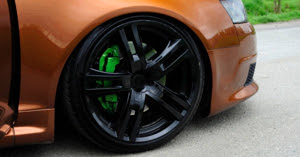Lower profile tires generally provide better road control, particularly in terms of handling and responsiveness, but with important caveats depending on road conditions and driving context.
- Improved Handling and Responsiveness: Low-profile tires have stiffer sidewalls and a wider tread, which reduces sidewall flex and increases the tire's contact patch with the road. This leads to sharper steering response, greater stability, and enhanced cornering ability, especially at higher speeds or during aggressive driving. These characteristics make low-profile tires a popular choice for sports and performance vehicles[1][2][3][4][5].
- Better Braking Performance: The larger contact patch and stiffer construction can improve braking distances, particularly on dry pavement, giving drivers more confidence in emergency situations[1][2][4].
- More Precise Steering: Reduced sidewall flex means steering inputs are transferred more directly to the road, resulting in a more connected and controlled driving experience[3][6].
However, there are trade-offs and limitations:
- Rougher Ride: The reduced sidewall height provides less cushioning, so low-profile tires transmit more bumps and road imperfections to the cabin, leading to a firmer and sometimes uncomfortable ride[2][3][4][7][5].
- Increased Risk of Damage: Shorter sidewalls are more susceptible to damage from potholes, curbs, and rough roads[2][3].
- Variable Grip in Adverse Conditions: While low-profile tires excel on dry, smooth roads, their stiffer sidewalls and reduced ability to conform to uneven surfaces can reduce grip on wet, snowy, or rough roads. High-profile tires, with more flexible sidewalls, can maintain a more consistent contact patch in these conditions, sometimes providing better traction[2][6].
- Not Always Better for All Driving Scenarios: For everyday driving, especially on imperfect roads or in winter conditions, the benefits of low-profile tires may be outweighed by their drawbacks[2][6][7].
"Low profile tires have a stiffer side wall meaning it doesn't flex side to side... that makes the car feel sharper and more responsive because all the steering input gets transferred to the road almost instantly... but when the road gets wet things change... a high-profile tire has a more flexible side wall which allows it to conform to the road surface better, improving grip in not just rain but also snow and even off-road"[6].
In summary, lower profile tires do give better road control in terms of handling, steering precision, and braking on smooth, dry surfaces, but they are not universally superior in all conditions. The choice should be based on your driving priorities and typical road conditions[1][2][3][4][6][7][5].
⁂
- https://rnrtires.com/tips-guides/pros-and-cons-of-low-profile-tires-explained/
- https://www.parkmuffler.com/blog/low-profile-vs-regular-tires/
- https://www.gtradial-us.com/blog/what-are-low-profile-tires-the-importance-of-tire-aspect-ratio/
- https://www.utires.com/articles/what-are-low-profile-tires-used-for/
- https://www.oponeo.co.uk/blog/low-profile-tyres-advantages-and-disadvantages
- https://www.youtube.com/watch?v=QSdYJ0cFj1E
- https://mechanics.stackexchange.com/questions/846/what-are-the-benefits-of-low-profile-tires


No comments:
Post a Comment